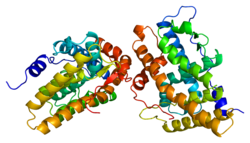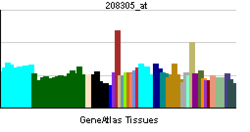孕酮受体
外观
孕酮受体(英語:progesterone receptor,缩写PR,也被称为NR3C3 ,nuclear receptor subfamily 3, group C, member 3,即核受体第三亚族C组成员3)是一种细胞内蛋白质,由甾体激素孕酮激活。
在人体中,孕酮受体由基因PGR 编码,位于11号染色体长臂22区[1][2][3],能通过选择性剪接形成两种蛋白异形体A和B,有着各自不同的分子量[4][5][6]。
功能
[编辑]孕酮是引起孕酮受体反应的配体,在孕酮受体的C端未结合该激素时,与其相关的DNA片段的转录处于抑制状态。在与激素结合后,孕酮受体会变构并开始起作用。而孕酮受体的受体拮抗剂会阻止这种结构改变。
在孕酮与其受体结合后,孕酮受体变构并发生二聚化,紧接着以复合体形式进入细胞核与相关的DNA结合,从而使其开始转录,合成mRNA,并表达为相关蛋白质。
结构
[编辑]| Progesterone receptor, N-terminal | |||||||||
|---|---|---|---|---|---|---|---|---|---|
| 鑑定 | |||||||||
| 標誌 | Progest_rcpt_N | ||||||||
| Pfam | PF02161(旧版) | ||||||||
| InterPro | IPR000128 | ||||||||
| |||||||||
和其它甾体激素受体类似,孕酮受体的N端有一个调控结构域,一个DNA结合结构域,以及一个铰链区,在C端有一个配体结合结构域。异形体B比异形体A多一个TAF-3区域。
交互作用
[编辑]孕酮受体能与下列蛋白質发生交互作用:
另见
[编辑]参考文献
[编辑]- ^ Misrahi M, Atger M, d'Auriol L, Loosfelt H, Meriel C, Fridlansky F, Guiochon-Mantel A, Galibert F, Milgrom E. Complete amino acid sequence of the human progesterone receptor deduced from cloned cDNA. Biochem. Biophys. Res. Commun. March 1987, 143 (2): 740–8. PMID 3551956. doi:10.1016/0006-291X(87)91416-1.
- ^ Law ML, Kao FT, Wei Q, Hartz JA, Greene GL, Zarucki-Schulz T, Conneely OM, Jones C, Puck TT, O'Malley BW. The progesterone receptor gene maps to human chromosome band 11q13, the site of the mammary oncogene int-2. Proc. Natl. Acad. Sci. U.S.A. May 1987, 84 (9): 2877–81. PMC 304763
 . PMID 3472240. doi:10.1073/pnas.84.9.2877.
. PMID 3472240. doi:10.1073/pnas.84.9.2877.
- ^ ensembl.org, Gene: ESR1 (ENSG00000091831). [2014-06-28]. (原始内容存档于2022-01-05).
- ^ Gadkar-Sable S, Shah C, Rosario G, Sachdeva G, Puri C. Progesterone receptors: various forms and functions in reproductive tissues. Front. Biosci. 2005, 10: 2118–30. PMID 15970482. doi:10.2741/1685.
- ^ Kase, Nathan G.; Speroff, Leon; Glass, Robert L. Clinical gynecologic endocrinology and infertility. Hagerstown, MD: Lippincott Williams & Wilkins. 1999. ISBN 0-683-30379-1.
- ^ Fritz, Marc A.; Speroff, Leon. Clinical gynecologic endocrinology and infertility. Hagerstown, MD: Lippincott Williams & Wilkins. 2005. ISBN 0-7817-4795-3.
- ^ Zhang XL, Zhang D, Michel FJ, Blum JL, Simmen FA, Simmen RC. Selective interactions of Kruppel-like factor 9/basic transcription element-binding protein with progesterone receptor isoforms A and B determine transcriptional activity of progesterone-responsive genes in endometrial epithelial cells. J. Biol. Chem. June 2003, 278 (24): 21474–82. PMID 12672823. doi:10.1074/jbc.M212098200.
- ^ Giangrande PH, Kimbrel EA, Edwards DP, McDonnell DP. The opposing transcriptional activities of the two isoforms of the human progesterone receptor are due to differential cofactor binding. Mol. Cell. Biol. May 2000, 20 (9): 3102–15. PMC 85605
 . PMID 10757795. doi:10.1128/MCB.20.9.3102-3115.2000.
. PMID 10757795. doi:10.1128/MCB.20.9.3102-3115.2000.
- ^ Nawaz Z, Lonard DM, Smith CL, Lev-Lehman E, Tsai SY, Tsai MJ, O'Malley BW. The Angelman syndrome-associated protein, E6-AP, is a coactivator for the nuclear hormone receptor superfamily. Mol. Cell. Biol. February 1999, 19 (2): 1182–9. PMC 116047
 . PMID 9891052.
. PMID 9891052.
延伸阅读
[编辑]- Butnor KJ, Burchette JL, Robboy SJ. Progesterone receptor activity in leiomyomatosis peritonealis disseminata. Int. J. Gynecol. Pathol. 2002, 18 (3): 259–64. PMID 12090595. doi:10.1097/00004347-199907000-00012.
- Leonhardt SA, Boonyaratanakornkit V, Edwards DP. Progesterone receptor transcription and non-transcription signaling mechanisms. Steroids. 2004, 68 (10–13): 761–70. PMID 14667966. doi:10.1016/S0039-128X(03)00129-6.
- Conneely OM, Mulac-Jericevic B, Lydon JP. Progesterone-dependent regulation of female reproductive activity by two distinct progesterone receptor isoforms. Steroids. 2004, 68 (10–13): 771–8. PMID 14667967. doi:10.1016/S0039-128X(03)00126-0.
- Bagchi MK, Tsai SY, Tsai MJ, O'Malley BW. Ligand and DNA-dependent phosphorylation of human progesterone receptor in vitro. Proc. Natl. Acad. Sci. U.S.A. 1992, 89 (7): 2664–8. PMC 48722
 . PMID 1557371. doi:10.1073/pnas.89.7.2664.
. PMID 1557371. doi:10.1073/pnas.89.7.2664. - Kastner P, Krust A, Turcotte B; et al. Two distinct estrogen-regulated promoters generate transcripts encoding the two functionally different human progesterone receptor forms A and B. EMBO J. 1990, 9 (5): 1603–14. PMC 551856
 . PMID 2328727.
. PMID 2328727. - Guiochon-Mantel A, Loosfelt H, Lescop P; et al. Mechanisms of nuclear localization of the progesterone receptor: evidence for interaction between monomers. Cell. 1989, 57 (7): 1147–54. PMID 2736623. doi:10.1016/0092-8674(89)90052-4.
- Fernandez MD, Carter GD, Palmer TN. The interaction of canrenone with oestrogen and progesterone receptors in human uterine cytosol. British Journal of Clinical Pharmacology. 1983, 15 (1): 95–101. PMC 1427833
 . PMID 6849751. doi:10.1111/j.1365-2125.1983.tb01470.x.
. PMID 6849751. doi:10.1111/j.1365-2125.1983.tb01470.x. - Oñate SA, Tsai SY, Tsai MJ, O'Malley BW. Sequence and characterization of a coactivator for the steroid hormone receptor superfamily. Science. 1995, 270 (5240): 1354–7. PMID 7481822. doi:10.1126/science.270.5240.1354.
- Zhang Y, Beck CA, Poletti A; et al. Identification of phosphorylation sites unique to the B form of human progesterone receptor. In vitro phosphorylation by casein kinase II. J. Biol. Chem. 1995, 269 (49): 31034–40. PMID 7983041.
- Mansour I, Reznikoff-Etievant MF, Netter A. No evidence for the expression of the progesterone receptor on peripheral blood lymphocytes during pregnancy. Hum. Reprod. 1995, 9 (8): 1546–9. PMID 7989520.
- Kalkhoven E, Wissink S, van der Saag PT, van der Burg B. Negative interaction between the RelA(p65) subunit of NF-kappaB and the progesterone receptor. J. Biol. Chem. 1996, 271 (11): 6217–24. PMID 8626413. doi:10.1074/jbc.271.11.6217.
- Wang JD, Zhu JB, Fu Y; et al. Progesterone receptor immunoreactivity at the maternofetal interface of first trimester pregnancy: a study of the trophoblast population. Hum. Reprod. 1996, 11 (2): 413–9. PMID 8671234. doi:10.1093/humrep/11.2.413.
- Thénot S, Henriquet C, Rochefort H, Cavaillès V. Differential interaction of nuclear receptors with the putative human transcriptional coactivator hTIF1. J. Biol. Chem. 1997, 272 (18): 12062–8. PMID 9115274. doi:10.1074/jbc.272.18.12062.
- Jenster G, Spencer TE, Burcin MM; et al. Steroid receptor induction of gene transcription: a two-step model. Proc. Natl. Acad. Sci. U.S.A. 1997, 94 (15): 7879–84. PMC 21523
 . PMID 9223281. doi:10.1073/pnas.94.15.7879.
. PMID 9223281. doi:10.1073/pnas.94.15.7879. - Shanker YG, Sharma SC, Rao AJ. Expression of progesterone receptor mRNA in the first trimester human placenta. Biochem. Mol. Biol. Int. 1997, 42 (6): 1235–40. PMID 9305541.
- Richer JK, Lange CA, Wierman AM; et al. Progesterone receptor variants found in breast cells repress transcription by wild-type receptors. Breast Cancer Res. Treat. 1998, 48 (3): 231–41. PMID 9598870. doi:10.1023/A:1005941117247.
- Williams SP, Sigler PB. Atomic structure of progesterone complexed with its receptor. Nature. 1998, 393 (6683): 392–6. PMID 9620806. doi:10.1038/30775.
- Boonyaratanakornkit V, Melvin V, Prendergast P; et al. High-mobility group chromatin proteins 1 and 2 functionally interact with steroid hormone receptors to enhance their DNA binding in vitro and transcriptional activity in mammalian cells. Mol. Cell. Biol. 1998, 18 (8): 4471–87. PMC 109033
 . PMID 9671457.
. PMID 9671457. - Nawaz Z, Lonard DM, Smith CL; et al. The Angelman syndrome-associated protein, E6-AP, is a coactivator for the nuclear hormone receptor superfamily. Mol. Cell. Biol. 1999, 19 (2): 1182–9. PMC 116047
 . PMID 9891052.
. PMID 9891052.


